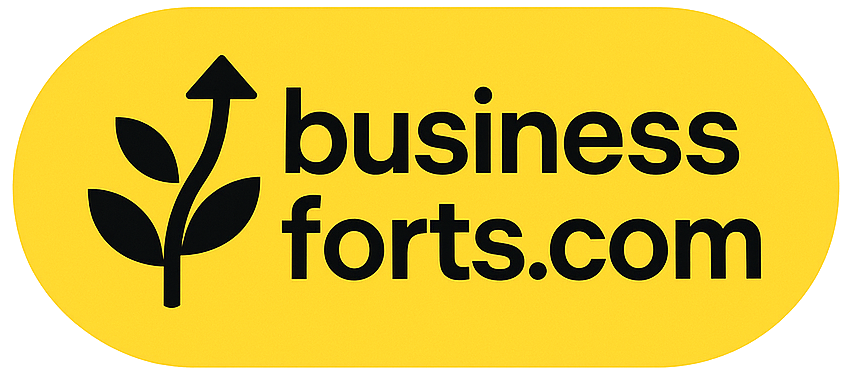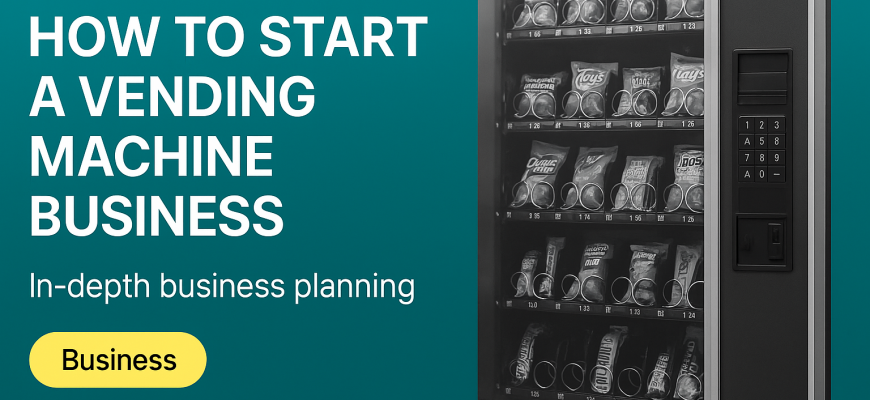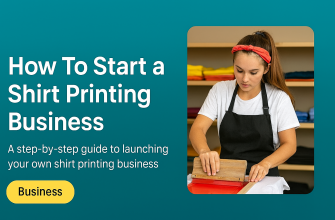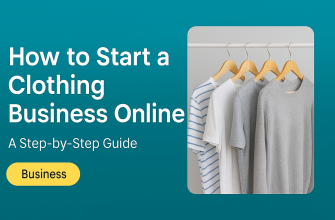Starting your own business is a bold and exciting move – and women are launching new ventures at record rates. In fact, women are creating new businesses five times faster than the national average, now owning over 11 million businesses (about 39% of all U.S. firms). If you’ve been dreaming about entrepreneurship, you have the power and potential to succeed. One accessible path to consider is the vending machine business – a flexible, scalable opportunity that can generate passive income and fit into your lifestyle. This in-depth guide will walk you through how to start a vending machine business, with step-by-step planning advice, practical tips to keep costs low, and plenty of encouragement tailored for women entrepreneurs ready to make their mark.
- Why Vending Machines? – Flexibility, Growth & Empowerment
- Step 1: Research Your Market and Craft a Business Plan
- Step 2: Choose the Right Type of Vending Machine for Your Business
- Step 3: Calculate Startup Costs and Explore Financing Options
- Step 4: Handle Licenses, Permits, and Legal Essentials
- Step 5: Find Prime Locations and Negotiate Placement Contracts
- Step 6: Source Your Machines and Inventory like a Pro
- Step 7: Maintain Your Machines and Scale Up Strategically
- Conclusion: You’ve Got This – Step Into Your CEO Shoes
Why Vending Machines? – Flexibility, Growth & Empowerment
Launching a vending machine business offers several advantages that make it especially appealing for women balancing various roles and ambitions. Vending machines provide flexibility – you can often set your own schedule for restocking and maintenance, working it around family or other commitments. They also offer a relatively low-cost start (you can even finance machines to spread out costs), and once your machines are placed, the business can generate income with minimal supervision. Many women appreciate that a vending side-hustle or enterprise can be scaled at your pace. You might begin with a single machine and gradually add more as time and budget allow, growing your empire on your own terms.
Another empowering aspect is the passive income potential. Vending machines make sales 24/7 without you being physically present – “the machine handles all the transactions for you, and all you need to do is go collect the money”. Over time, you can even outsource tasks like refilling machines or bookkeeping as your profits grow. Imagine earning money even on days you’re focused on family or taking a well-deserved break – that’s the kind of freedom this business can offer.
Lastly, as a woman entrepreneur, you can bring a unique touch to this industry. Perhaps you’ll specialize in healthy snacks for busy moms, eco-friendly products, or items that cater to women’s needs (how about a vending machine with essential toiletries or beauty accessories?). The possibilities are vast, and success is not limited by gender – numerous women have built profitable vending ventures. With determination and the insights below, you can join them.
Step 1: Research Your Market and Craft a Business Plan
Every great business starts with a solid plan. Begin by researching your market and choosing a vending niche that excites you. Ask yourself: What products do people in my community or target area need or want on-the-go? Look for gaps or unmet needs. For example, is there demand for healthier snack options at local gyms or schools? Are there office parks lacking convenient drink machines? Or maybe a popular transit station where travelers could use phone chargers or travel-size essentials from a machine. By doing some homework – observing foot traffic, noting existing vending services, and even surveying potential customers – you can identify a promising niche.
Choose what to sell: Focus on products you’re passionate about and that have profit potential. Common vending choices include snacks and beverages (the classic chips, candy and sodas) – these are the most popular segment, making up roughly 30% of U.S. vending sales. But there’s also a world of specialty options. You could vend healthy organic snacks and drinks at fitness centers, offer toiletries and personal care items in malls or airports, stock office supplies in a corporate building, or even serve up hot coffee and espresso in a busy transit hub. Some entrepreneurs get creative with machines selling electronics accessories, PPE, cosmetics, or local artisanal products. When deciding, consider product cost vs. profit margin and shelf-life. Perishable foods (like fresh sandwiches or salads) can be appealing but require quick turnover and more food safety compliance, whereas prepackaged snacks are simpler to manage. Pick a lane that aligns with your goals and your market’s needs.
Write your business plan: Treat this like a real business from day one. Outline the vision and mission for your vending company – even if it’s just you running it, a plan gives you direction. Include key elements like:
-
Market analysis: Who are your target customers and what do they want? (e.g. gym-goers wanting protein bars, students needing affordable snacks).
-
Competitive research: Who else has machines in your area? How will you differentiate (perhaps by better service, unique products, or targeting underserved locations)?
-
Startup and operating costs: We’ll dig into costs next, but start listing expenses like machines, initial inventory, fuel for restocking trips, any storage or vehicle needs, licenses, etc.
-
Pricing and revenue projections: Estimate how much you’ll charge per item and how many sales a location might generate. (Tip: Many vending machines average around $300–$600 in revenue per month, though high-traffic spots can do more. Use this as a ballpark when projecting.)
-
Marketing and growth plan: How will you find and pitch locations to place your machines? What are your expansion goals (e.g., add one new machine every 6 months)?
-
Business structure: Will you start as a sole proprietor or form an LLC for liability protection? Many vending owners choose an LLC to separate personal and business assets as they grow, which is worth considering down the line.
Putting your ideas on paper not only clarifies your path – it builds your confidence. It’s a lot easier to approach a site owner or a lender when you have a plan in hand. Remember, this is your venture – design it to reflect your passion and values. Don’t shy away from thinking big. As a woman in business, your vision is your strength – use it to map out a vending concept that excites you and fills a niche in the market.
Step 2: Choose the Right Type of Vending Machine for Your Business
Not all vending machines are created equal. There are different types of machines designed for various products, and choosing the right one is crucial. Your choice will depend on what you’re selling and where you’ll place the machine. Here’s a breakdown of common vending machine types and their uses:
-
Snack Vending Machines: These machines dispense chips, candy, cookies, and other packaged snacks. They’re ubiquitous in offices, schools, and malls. Cost: New snack machines typically start around $3,000. They usually have coil dispensers and can hold dozens of products. If your focus is on munchies and treats, or healthier snack bags, this is your go-to.
-
Beverage Vending Machines: Designed for canned or bottled drinks (sodas, water, energy drinks, etc.), these come with refrigeration. They often have slots for 8–10 drink varieties. Cost: Beverage machines range roughly $3,000–$5,000 when new. Drinks are high-demand items in almost any venue. Keep in mind the weight (you’ll be lugging drink cases) and electricity needs for cooling.
-
Combo Machines: These versatile machines offer both snacks and drinks in one unit. They’re great for smaller locations that want the best of both worlds but only have space (or budget) for one machine. Cost: Combination machines start around $3,000 and can go up to $7,000 depending on features. A combo machine might have two sections – one refrigerated for drinks and another at room temp for snacks.
-
Candy & Bulk Machines: Think of the small gumball or candy machines you see at storefronts or restaurants – these are bulk vending devices. They dispense handfuls of candy, nuts, capsules with toys, etc., usually for a coin or two. Cost: They are much cheaper – often $200–$500 used, or around $1,500 new for a multi-head candy machine. They don’t require electricity and are easy to maintain, but profits per machine are lower. However, they can be a fun, low-risk way to start (even a child can run a gumball route!).
-
Specialty Vending Machines: Beyond the classics, there’s a whole world of specialized vending machines. These can carry anything from hot coffee or freshly brewed drinks (common in workplaces and transit stations) to frozen meals and ice cream, or niche products like electronics, cosmetics, PPE, even pharmaceuticals. For example, some airports have vending machines for phone chargers and headphones, while gyms might have ones with protein shakes and supplements. Cost: Specialty machines with high-end features (touchscreens, custom compartments, heating/cooling systems) can be pricey – often $5,000–$10,000+ new. But they allow you to carve out a unique market. If you identify a strong niche (say, a “mom-preneur” who sets up diaper-and-wipes vending machines in public parks), a specialty machine could give you an innovative edge.
When selecting a machine type, consider maintenance and features too. Modern vending machines can come with useful features like credit card readers and mobile payment acceptance, inventory tracking software, or LED lighting and displays for advertising. While these add cost, they can increase sales (for instance, accepting cards/mobile pay opens you to customers who don’t carry cash). As you’re just starting, it’s fine to keep it simple – you can always upgrade components later. The key is to match your machine to your product and location: a snack/drink combo might be perfect for an office, but a refrigerated soda machine is a must for an outdoor sports park in summer.
Take time to research machine suppliers. You can buy machines new from manufacturers or authorized dealers, who often provide warranties and tech support. There are also many used machines available via online marketplaces (e.g., Craigslist, Facebook Marketplace, eBay) or local sellers – used units can cost significantly less, but be sure to inspect them or buy from a reputable refurbisher to avoid constant breakdowns. Leasing is another option if you want to conserve cash; many suppliers offer leasing plans starting around $100–$250 per month per machine. Leasing can include maintenance services in some cases, but read the fine print. Whether you decide to buy new, buy used, or lease, choose machines that fit your budget and business goals.
Empowerment Tip: You belong in this industry. Vending has traditionally been male-dominated, but that’s changing as more women enter this space with fresh ideas (there are even franchises and associations dedicated to healthy vending that many women lead). Don’t be intimidated by the technical side of machines – they’re actually quite user-friendly, and you can always learn as you go. If something needs fixing, there are YouTube tutorials, manuals, and technician services available. Many women entrepreneurs before you have mastered the nuts and bolts, and so can you!
Step 3: Calculate Startup Costs and Explore Financing Options
One of the first questions to tackle is “How much will it cost to start?” The good news: a vending machine business has relatively low startup costs compared to many other businesses, and you can scale your investment up or down. Here are the typical cost components to plan for:
-
Vending machines: This will likely be your biggest expense. New machines can range from around $3,000 up to $10,000 or more, depending on type and features. As noted, basic snack or drink models are on the lower end, while larger and high-tech machines cost more. Used machines can be far cheaper – often between $1,000–$3,000 for a good quality used snack or drink machine, or a few hundred dollars for a simple bulk candy machine. Plan your machine budget based on how many units you want to start with. (Starting with 1–3 machines is common for newbies.)
-
Initial inventory: You’ll need products to stock your machines. The cost depends on what you’re selling. A typical snack machine might take $200–$400 worth of inventory to fill initially, whereas a drink machine could require a similar amount for cases of beverages. You won’t pay this all the time – these goods turn into revenue as they sell – but you need some starting stock. Buying in bulk (e.g., a 36-count box of chips, a 24-pack of soda) lowers the per-item cost. We’ll discuss sourcing soon, but budget a few hundred dollars per machine for initial fill and some backup inventory.
-
Licenses and permits: Starting a legitimate business means handling paperwork (more on this later in Step 5). Many areas require a general business license, and if you’re selling taxable goods (most snacks and drinks are taxable), you’ll need a sales tax permit (often free or low-cost to obtain). If selling perishable food, possibly a health permit. These fees are usually not very high – often in the range of $50 to a few hundred dollars in total. Check your local requirements.
-
Insurance: It’s wise to insure your business and machines. A general liability insurance policy can protect you if, say, someone claims injury from a machine or if a machine causes property damage. Insurance also can cover theft or vandalism of your equipment. Rates vary, but a basic policy for a small vending operation might be a few hundred dollars per year. If you use a vehicle for business (e.g., to transport inventory), factor in auto insurance and fuel. In the beginning, your normal car might suffice, but keep track of mileage and gas used for business.
-
Miscellaneous: Other costs could include machine delivery fees (if not included in purchase), a coin changer/cash loader fund (each machine might need a bank of change – you’ll stock it with some quarters and dollar bills as float), branding or wraps for your machine (optional), and small equipment like a dolly for moving products, storage bins, or a basic toolkit for minor repairs.
Add these up to get your estimated startup cost. For many first-time vending entrepreneurs, total startup costs fall in the range of $2,000 to $10,000 depending on how many machines and whether they’re used or new. It’s very feasible to start on the lower end of that range by buying a used machine or two and using personal savings.
Financing options: If you don’t have enough cash upfront, don’t worry – there are financing avenues to explore. Many vending machine distributors or manufacturers offer financing plans or leases (as mentioned, machines “can be financed” which helps mitigate high upfront cost). You could also consider a small business loan or line of credit. Since vending businesses have hard assets (the machines) and predictable cash flow, some lenders are willing to finance them. Check with your bank or institutions like the U.S. Small Business Administration (SBA) for microloans. Grants are another possibility – there are grants specifically for small businesses and some aimed at women entrepreneurs (though these can be competitive). It doesn’t hurt to research programs in your area or nationally, such as Amber Grant for Women, local economic development grants, or SBA-backed Women’s Business Centers that sometimes have funding resources. While you shouldn’t rely solely on winning a grant, it’s an option to pursue alongside other efforts.
If you’re wary of taking on debt, you can start small and reinvest your earnings. Maybe you begin with one modest used machine that you can afford now. As that machine generates profit, you save up and buy a second one, and so on. There’s no rule that you must launch with multiple machines at once – there’s pride in building brick by brick. Many successful vending operators started as a side hustle, then grew into full-time business owners by rolling their profits into expansion.
Keep expenses low – smart strategies: Every dollar saved is a dollar earned, especially early on. Here are some cost-cutting tips as you launch:
-
Buy quality used equipment: As noted, a used machine can cost a fraction of new. If you find a reliable second-hand machine in good working order, grab it – just ensure you see it in action or get a short warranty. A $1,000 used machine that works well will boost your ROI much faster than a $4,000 new one.
-
Negotiate or avoid location commissions: We’ll cover location contracts soon, but know that not all locations demand a high commission. Some small businesses might even let you place a machine at no charge if it’s a perk for their employees or customers. Aim to negotiate fair terms – the typical commission paid to a host location ranges from about 5% up to 20% of sales. If you can secure a spot at the low end of that range (or a flat electricity fee instead), you keep more profit.
-
Minimize ongoing overhead: In the beginning, you can do all the work yourself – stocking, collecting cash, cleaning – so you have no payroll costs. Use your personal vehicle to service machines (no need for a special truck unless you scale up). Buy inventory in bulk from discount suppliers (Costco, Sam’s Club, etc.) to get the lowest unit cost. Also, try to reduce waste – don’t overstock perishable items that might expire; start with modest quantities until you know what sells.
-
Leverage technology wisely: Certain tech investments can save money long-term. For example, a remote monitoring system (via a smart reader or an app) can tell you when your machine is low on specific items, saving you unnecessary trips – meaning less gas expense and time wasted. While this might be something to add later, keep it in mind as you grow. There are affordable telemetry devices or even simple tricks like using smart plugs to monitor power status, etc. Efficiency is key when you’re juggling multiple responsibilities.
-
Continuous learning: Make use of free resources – join online forums or social media groups for vending operators, many of which openly share advice on cheap product sourcing, DIY fixes, and cost pitfalls to avoid. You’ll find a supportive community out there. And don’t hesitate to reach out to mentors or other women entrepreneurs for tips – empowerment often comes from lifting each other up and sharing knowledge.
By carefully planning your finances, exploring funding routes, and keeping a frugal mindset, you’ll set a strong foundation without breaking the bank. Remember: Every big business started small. It’s perfectly okay to start with a tight budget – your resourcefulness and creativity are more important than unlimited cash. Many women have bootstrapped their businesses to great success, and you can too.
Step 4: Handle Licenses, Permits, and Legal Essentials
Even as you get caught up in the excitement of choosing machines and products, don’t overlook the legal and administrative steps. Taking care of licenses, permits, and insurance early will protect your business and give you peace of mind to operate confidently. Here’s what to address:
Register your business: If you haven’t already, decide on your business name and legal structure. As a solo operator you can start as a sole proprietor, but many entrepreneurs prefer forming an LLC (Limited Liability Company) for a vending business. An LLC or corporation creates a legal separation between your personal assets and the business, which is valuable as you grow. It also allows you to get an EIN (Employer Identification Number) from the IRS (free) and open a business bank account. Opening a separate business bank account and maybe a credit card is highly recommended – it simplifies bookkeeping and solidifies that professional image. These steps are part of legitimizing your enterprise – and hey, seeing your business’s name on an official document can be a proud moment!
Obtain necessary licenses and permits: Requirements vary by city/state, but common ones for vending businesses include:
-
General Business License: Most jurisdictions require a basic business license to operate legally. This is usually obtained from your city or county clerk’s office.
-
Seller’s Permit/Sales Tax License: Since you’ll be selling goods, you likely need to collect sales tax on taxable items and remit it to the state. A seller’s permit (or resale permit) allows you to buy inventory wholesale without paying tax, and then collect tax from customers via the machine sales. Check your state’s taxation agency. (Some states tax food items differently, but snacks and sodas are usually taxable). Important: plan to price your items in a way that covers sales tax – many vending owners include tax in the vend price and later back-calculate it for reporting. For example, if you sell an item for $1.00 and tax is 7%, you actually net $0.93 and $0.07 goes to the state. Know your local rules.
-
Vending Machine License/Permit: Certain areas require a specific vending permit or even a sticker on each machine. For instance, you might need to register each machine with the city and pay an annual fee per machine (commonly this might be $10-$50 each). Not all places do this, but check with your city’s business regulations. They may classify vending machines under coin-operated machine regulations.
-
Health Permit (if applicable): If you sell perishable foods (e.g., sandwiches, fresh fruit, or hot drinks), the health department may need to inspect your operation or the machine. Even for prepackaged snacks, some locales require a food handling permit or at least adherence to certain standards (like keeping the machine clean, maintaining proper temperature for refrigerated items, etc.). Always “better safe than sorry” – ask your local health department if any permit is needed for the types of products you’ll have.
-
Other possible permits: If you plan to place machines outdoors or in public spaces, you might need zoning approval or special permission. Government buildings or schools often have extra red tape or restrictions (sometimes even bans on certain junk foods due to nutrition guidelines). If your location is on government property, inquire about any unique requirements.
Before launching, research federal, state, and local regulations for vending businesses. A quick call to your city’s Small Business office or a visit to the state’s website can clarify this. It may seem like a hassle, but running afoul of licensing laws can result in fines or having your machine shut down, so it’s worth the effort upfront. Many women entrepreneurs have shared that getting comfortable with the legal side of business is empowering – it’s part of owning your role as a CEO. You’ve got this detail under control!
Insurance: Protecting your business with insurance is a must. At minimum, consider General Liability insurance, which covers accidents or injuries related to your machine. For example, if someone claims they hurt themselves trying to rock a snack loose, or if a machine malfunctions and causes damage, you want coverage. Additionally, since your machines are assets, you might want property insurance or a rider to cover theft, vandalism, or damage (some general liability policies include this, or you can add an equipment coverage). If you’ll be driving a lot to service machines, ensure your auto insurance knows you use the vehicle for business – or get a commercial auto policy if needed (especially if you have a branded vehicle or a larger truck/van). And if you hire employees as you grow, you’ll need Workers’ Compensation insurance as required by law.
Shop around for insurance quotes; there are insurers that specialize in small businesses and even vending businesses. The peace of mind is well worth the cost. One incident can set you back thousands if you’re uninsured, whereas insurance might be a few hundred per year. Think of it as an investment in your business’s stability.
Taxes and accounting: Once you’re operational, keep good records of income and expenses. You’ll need to report your profits on your taxes (if you’re an LLC, typically this flows through to your personal tax return). Using an app or simple accounting software to track sales per machine, inventory purchases, mileage, etc., will make life easier come tax time. Since women often wear many hats, a bit of organization here prevents headaches later. Some vending machines with smart systems can generate sales reports, but even a spreadsheet works when you have only a couple machines. Also mark your calendar for sales tax filing deadlines (some states require quarterly filing of collected sales tax). Staying compliant with tax filings, licenses, and reports is key to avoiding penalties.
All these administrative steps might not be the glamorous part of entrepreneurship, but they are the supportive framework that lets your venture thrive without costly disruptions. Completing them is an accomplishment in itself – you are officially a business owner! Take a moment to congratulate yourself when you register that business name or get your license approved. You’re not just vending snacks; you’re CEO of your own company – and that’s powerful.
Step 5: Find Prime Locations and Negotiate Placement Contracts
“Location, location, location!” – It’s an old saying but incredibly true for vending machines. The success of your machine rises and falls on where it’s placed. A well-placed vending machine in a high-traffic, hungry/thirsty location can far outperform one hidden in a corner with little foot traffic. So, how do you find those golden spots and secure them? Let’s break it down.
Brainstorm ideal locations: Think about places where people spend time and could use a quick snack or drink (or whatever product you’re vending). Some top location ideas include:
-
Office buildings and Corporate break rooms – Employees often want coffee, soda, or munchies without leaving the building. Offices with 50+ staff can support vending, and many companies like providing this convenience.
-
Schools, Colleges and Universities – Students are prime snackers. (Just check any school hallway between classes!) You might need special permission for schools, but colleges often have vendor programs.
-
Apartment complexes – Large apartment buildings or dorms sometimes have vending in lobbies or laundry rooms, great for late-night cravings.
-
Laundromats – Washing clothes is dull; people will definitely buy a soda or snack while waiting. Plus, laundromats are open long hours.
-
Hospitals and Medical Centers – Visitors and staff alike appreciate vending options since they may not have time to sit for a meal. If you have healthy options, even better for health-conscious environments.
-
Transportation Hubs (Airports, Bus/Train Stations) – Travelers often need drinks, snacks, or travel essentials. These can be lucrative, though competition and regulations are higher.
-
Shopping Malls and Retail Stores – Malls often have vending in corridors. Large retail stores might allow a machine near the exit (some have vending for drinks as customers leave).
-
Gyms and Fitness Centers – People coming out of a workout might grab a protein bar, water, or sports drink. Healthy items do well here.
-
Parks, Community Centers and Recreation Facilities – Seasonal but can be great for beverages in the summer, or snacks at community pools, skating rinks, etc.
-
Hotels and Motels – Many hotels have vending for guests on certain floors or in the lobby. If the hotel doesn’t want to manage it themselves, they might contract you.
-
Movie Theaters or Entertainment Venues – When concessions are closed or for smaller theaters, vending can fill a need (with perhaps candy or drinks).
-
Truck stops and Gas stations – Some have vending machines alongside convenience stores, to cater to after-hours or fill gaps in offerings.
As you can see, opportunities are everywhere. Start local – perhaps there’s an office park you drive by every day, or your kid’s school, or the gym you visit. Make a list of prospects and prioritize those with lots of people and a fitting need for what you sell.
Make your pitch: Once you identify a potential location, the next step is approaching the property owner or manager. This can be intimidating, but remember – you’re offering a service that can benefit them too. Prepare a simple proposal or talking points covering: what your machine will offer, the advantages to the location, and the terms you’re proposing. For example, if approaching a business owner: explain that you’d like to place a vending machine in their break area to serve their employees, you’ll keep it stocked with quality snacks/drinks, maintain it regularly, and bonus: it costs them nothing and even provides a commission or small rental fee for the space. Emphasize reliability – many businesses have had bad experiences with empty or broken machines, so assure them you’re local, motivated, and will keep the machine clean and operational. If you have healthy options or special products, mention how that adds value (e.g., “I offer healthier snack choices, which your employees might appreciate for afternoon energy”). Essentially, frame it as a win-win.
For public or high-traffic commercial locations, you might talk to the facilities manager or whoever handles vendor contracts. If you’re not sure who to approach, ask around – e.g., for an apartment building, the leasing office is a good start; for a store, the store manager or owner.
Negotiating placement terms: When a location is interested, you’ll typically discuss two main things – space and compensation. Most venues won’t charge you traditional “rent” for a small corner a machine occupies, but they often expect a commission on sales or a monthly fee to cover electricity and as a goodwill payment. A common approach is a commission percentage of the machine’s gross sales. This can vary widely: some experts say ~7% is common, while others note it can go up to 15–25% depending on the foot traffic and desirability of the spot. For example, a prime location like a busy mall might demand 20%+, whereas a small office might accept 0–10%. Run the numbers to ensure you can still profit with the commission – it should be high enough to motivate the location to host you, but reasonable enough that you still make money. NerdWallet notes that 5% to 25% is the typical range, so use that as a guideline.
Put everything in writing with a simple contract. The contract (or agreement letter) should cover basics like: the location granting you permission to place X machine(s) at Y location; the responsibilities (you will maintain, stock, and service the machine; they will provide electricity and access during certain hours); the commission rate or rent and when it’s paid (e.g., you’ll pay quarterly based on sales records or a flat $X per month); contract length or renewal terms; and what happens if either party wants to terminate. Also consider clauses like who’s liable if the machine causes any damage (usually you), or if there’s an exclusivity agreement (some locations promise you exclusivity – they won’t allow another vendor with competing machines – which is nice but not always given). Having a clear agreement prevents misunderstandings. Many vending contracts include points such as commission %, service responsibilities, machine ownership, and a termination clause if the arrangement isn’t working out.
Don’t be afraid to negotiate as an equal. As women, we sometimes hesitate to assert our terms, but believe in the value you’re bringing. It’s perfectly fine to negotiate commission – if a site asks 25% and that feels too high, explain your cost structure and counter with what you can sustainably do. Often, they’ll appreciate the transparency. You can also get creative: maybe instead of a higher commission, you offer a perk like donating a portion of proceeds to a charity (which can make the business look good), or you stock some free product for employees each month. Make it a conversation.
Once terms are settled, sign the contract and get that machine in place! When you install, ensure the machine is level, plugged in, and working well. Stock it up and make it look attractive. First impressions matter – a clean, well-stocked machine will start off on the right foot with users.
Safety and accessibility: When placing your machine, follow any site guidelines. Also consider ADA compliance – in the U.S., vending machines accessible to the public should allow reach from a wheelchair (generally controls below 48 inches). Most modern machines comply, but placement (like not blocking with furniture) is key. Also try to position in a well-lit, safe area to deter vandalism and make customers (especially women using it late hours) feel secure.
Finding that first location might be the hardest, but it gets easier after the first “yes.” Use your network – perhaps a friend or family member can facilitate an introduction to a business owner. Every successful placement will boost your confidence. You’re not just asking for a favor – you’re a businesswoman making a professional proposal. Keep your head high and remember that your time is valuable too. If someone isn’t interested, thank them politely and move on – something better will come. Persistence is key; that perfect location is out there waiting for your machine!
Step 6: Source Your Machines and Inventory like a Pro
With a location (or a few) lined up and permits in hand, it’s time for the exciting part – getting your vending machine and filling it with products! Smart sourcing can significantly affect your bottom line, so let’s go over best practices for acquiring both machines and inventory.
Acquiring vending machines: By now you likely know whether you’re buying new, used, or leasing. Here are some tips for each route:
-
Buying New: Identify reputable manufacturers or distributors. Big names in vending machines include Dixie-Narco, Crane, Vendo, Seaga, AMS, etc. You can contact them or their authorized resellers. New machines come with warranties (often 1-2 years) and the latest features. Don’t hesitate to negotiate price or ask for added value – sometimes dealers throw in a card reader or a supply of product to close a sale. Also factor in shipping or delivery fees; vending machines are heavy (snack machines ~600 lbs, drink machines even more), so you may need it delivered on a pallet and moved with a dolly or lift. Ensure the machine dimensions fit through doorways at your location!
-
Buying Used: When buying used, always test the machine if possible. Check every selection, coin and bill validator, and any digital display. Look for signs of wear or jury-rigged fixes. Ideally, buy locally so you can inspect in person. If buying online, use a platform with buyer protection or buy from a specialized used vending dealer who refurbishes machines. A refurbished machine from a dealer might cost a bit more than Craigslist but usually comes cleaned, with new parts where needed, and sometimes a short guarantee. Given that used machines can save you thousands, it’s worth hunting for deals – just avoid anything that seems too good to be true (e.g., a $100 machine that likely doesn’t work).
-
Leasing: If you opt to lease, clarify the terms: monthly payment, lease duration, and end-of-lease options (do you return the machine, or can you purchase it for a residual amount?). Leasing can come with a maintenance plan – confirm what repairs are covered. The advantage is low upfront cost and possible tax deductibility of payments. The downside is you may pay more over time. Ensure the cash flow from the machine can cover the lease payment with a cushion.
Whether new or used, clean your machine thoroughly before first use. Wipe down all surfaces, clean the inside racks or spirals (especially if it was used, sanitize it), and test vend multiple items to calibrate the coin mechanism and bill acceptor. Stock up on some spare parts that commonly need replacing: fuses, bulbs, maybe an extra coin mechanism or a spiral for each product size – these are relatively cheap and handy to have.
Sourcing inventory (products): This is where your inner bargain-hunter and quality-controller come in. To profit in vending, you need to get products at good wholesale prices. Here are common sources for vending inventory:
-
Wholesalers/Distributors: These are companies that sell snacks and drinks in bulk to retailers. Examples: Vistar is a major vending product distributor in the U.S., or regional snack distributors. You may need a resale license (seller’s permit) to buy from them. The prices are usually the lowest per unit, and selection is huge. They might deliver to you or have a cash-and-carry warehouse. The catch: they may have minimum orders or sell by the case, which can be a lot of product for a very small operation.
-
Cash & Carry Membership Clubs: Warehouse clubs like Sam’s Club, Costco, BJ’s are a vending operator’s friend. You can walk in and buy a flat of chips or a 24-pack of soda at near-wholesale prices without needing a special account. Many vending folks start here because you can get variety in reasonable quantities. For example, Sam’s Club often even labels certain items as “vending size” (e.g., candy bars or chip bags that fit machines) and you can buy one case at a time. It’s convenient and still cost-effective.
-
Specialty Product Brokers: If you plan to vend unique or healthy items (say, keto snacks, or local artisan granola bars), you might work with specialty food brokers or even directly with manufacturers. Brokers can get you a range of niche products but often at slightly higher cost and usually in bulk. This route makes sense if differentiation is key to your machine – just be mindful of shelf life and cost.
-
Direct from Retail (limited): In a pinch, you can buy items from grocery stores or discount retailers (like picking up a 12-pack of soda on sale). However, the margins are slimmer this way since you’re paying closer to retail price. Use this only for emergency restocks or to test new products in small quantities.
Aim to secure the lowest cost per unit for your inventory because that directly affects profit. For instance, if you can buy a case of 24 sodas for $12 (50¢ each) and sell each for $1.50, that’s a good margin. But if you pay $18 (75¢ each) for the same case, your profit per vend shrinks. Those dimes add up over hundreds of vends. Bulk buying and negotiation are your tools. If you grow, you might negotiate better rates with a distributor by buying higher volume.
Also, keep your product mix in mind: a variety of items will cater to more tastes, but you don’t have to go overboard. It’s often better to stock say 10 popular items consistently than 20 items where some slow-movers just take up space. You’ll learn what sells best by tracking sales. One approach is to start with proven popular snacks/drinks (the “classics” like Coke, Pepsi, popular chip brands, candy bars) and then later introduce a couple of new or healthy options to see if they catch on.
Setting competitive prices: Pricing your products requires balancing competitiveness, profitability, and even psychology. Research what other vending machines in your area charge – you don’t want to price far above the norm unless you offer something unique. For example, if most soda machines locally charge $1.50 for a 12oz can, pricing yours at $2.00 might reduce sales unless the convenience or location is unmatched. On the other hand, don’t undersell yourself – people expect to pay a bit of a convenience premium at vending machines, and a few extra cents on each item can mean the difference between thriving and barely breaking even.
A common strategy is to aim for roughly a 100% markup or more on most items. That means if an item costs you $0.50, you’d price it around $1.00 – $1.25. Some items can bear higher markups (candy often has high markup potential; bottled water bought in bulk is very cheap per bottle and can be sold at several times cost). Other items like healthy snacks might have a higher cost, so your percentage markup might be lower, but you might carry them to satisfy demand even if margin is thinner. Over time, calculate the gross profit per item after commissions and cost of goods – focus on items that yield solid profit and consider dropping those that barely contribute.
Don’t forget to account for sales tax in your pricing. If your machine isn’t going to add tax on top of the price (most vending prices are set as round figures), you need to imbue the tax in that price. For instance, if you want $1.00 after tax and tax is ~7%, you’d price at $1.07 (which is awkward on a machine) or more realistically $1.10 and then after you pay ~7¢ tax, you net $1.03. Many vendors just price in increments like $1.00, $1.25, $1.50, etc., and accept that a portion goes to tax. Build your desired profit margin with those factors in mind.
Finally, consider doing promotions or bundling if your machine technology allows (some advanced machines can do “2 for $X” deals). While not common on basic machines, you could manually create a combo (like one slot that contains say a small bag of chips taped to a candy bar as a “snack pack” for a special price). Creativity can attract more purchases.
Keep inventory fresh and appealing: Rotate stock regularly. Remove any item that’s nearing expiration if it hasn’t sold – better to replace it with something that will sell than have a customer get an expired product (which hurts your reputation). Track what sells quickly and what doesn’t – this is valuable data. If granola bars fly off the shelf but cookies stall, adjust accordingly. Part of being an entrepreneur is this experimental mindset: try new products in a small way, keep the winners, drop the losers. Eventually, you’ll fine-tune a selection that maximizes sales.
Sourcing and stocking are areas where attention to detail pays off. As a woman business owner, you might naturally excel at the detail-oriented work of keeping track of supplies, noticing patterns, and creating an inviting presentation. Play to those strengths. When you open your machine for service, take pride in making it look attractive – front-face the products (labels forward), maybe group healthier items together, ensure everything is in the correct slot with price labels accurate. A tidy, cared-for machine reflects on you as an operator and encourages people to make a purchase. You’re effectively running a tiny convenience store – stock it like you’d want to shop from it.
Step 7: Maintain Your Machines and Scale Up Strategically
Congratulations – you’ve placed your machine(s) and made your first sales! Now the ongoing work begins: operations and maintenance. Proper management will keep your business running smoothly and your customers happy. Additionally, as you gain experience, you can look toward scaling up – adding more machines or optimizing for efficiency. Let’s dive into how to manage multiple roles efficiently.
Regular maintenance and restocking: Create a schedule to check on each machine. The frequency depends on how busy the location is – a machine in a bustling area might need service twice a week, whereas a slower office machine maybe once every week or two. During each visit, you should:
-
Refill inventory: Top off popular items that sold out, and restock any low items. Initially, you may guess how often you need to refill, but sales data over a few weeks will reveal patterns. It’s better to visit before things run out – an empty coil is a missed sale and can frustrate would-be customers. If you can’t check often, consider adding a second coil of very popular items so they last longer between fills.
-
Collect cash (and restock change): Empty the coin box and bill validator of money. This is the fun part – counting your earnings! At the same time, ensure the coin mechanism has enough quarters or dollar coins to give change. If your machine takes bills, people will expect change for a $5, etc. Many modern machines can hold a lot of change; just keep an eye and refill change tubes as needed (you can use the coins you collect).
-
Clean and inspect: Wipe down the front glass and buttons – a clean machine is more inviting. Remove any trash or stuck items inside. Check that the lights are working and that no selection is malfunctioning. If you notice a particular slot didn’t sell anything while others did, test it – maybe that coil is jammed or the price isn’t set right. Regular cleaning also prevents pest issues (especially if any product spills or breaks open, clean it to avoid attracting ants or rodents).
-
Check expiry dates: Rotate stock so that older items are in front and will vend first. Remove anything past its expiration (this should be rare if you’re selling through, but keep an eye on slower sellers like certain healthy snacks or pastries). It’s better to lose a small cost on an expired item than to sell it and lose customer trust.
Troubleshooting: Eventually, you’ll encounter a machine issue – perhaps a coin jam, a bill validator that won’t take bills, or an electronic glitch. Don’t panic. Many issues have simple fixes (refer to the machine’s manual for troubleshooting tips). Carry a basic toolkit when you service machines: screwdrivers, pliers, maybe a multimeter, cleaning cloth, etc. YouTube is a lifesaver for vending machine fixes – often you can find someone demonstrating how to replace a vend motor or clear a coin jam. If it’s beyond your comfort, you can hire a vending technician. But each time you solve a technical problem yourself, your confidence grows. Women can be just as adept at mechanical tinkering – approach it as a puzzle rather than something intimidating. Over time, you’ll develop a routine and knack for keeping things running.
Customer service: Although vending is automated, you may occasionally deal with customer issues, like a coin got stuck or a product didn’t drop. Make it easy for users to reach you – many operators put a small sticker on the machine with a phone number or email for service. Respond promptly and professionally to any calls. For example, if someone lost money, apologize and either refund them or offer a free item next time. This level of care sets you apart. As a woman in business, excellent customer service is an area where you can truly shine and build a positive reputation. Locations will hear if their people are happy with the vending service, and that makes them glad they chose you.
Leveraging technology for efficiency: If you expand to several machines, consider investing in technology to streamline operations. Remote monitoring systems can send you alerts or let you check inventory levels and sales online. This can prevent wasted trips and immediately inform you if a machine has an issue (some systems alert if a machine goes offline or is unplugged). There are affordable add-on devices and also solutions built into some newer card readers that provide telemetry. Tracking sales data can help with inventory planning too – you’ll know exactly what sells when, allowing for smart restock planning.
Some operators use route planning software (or just Google Maps optimization) to plan the most fuel-efficient path when servicing multiple machines in one outing. Saving time on the road means more time for you (or more time to devote to expanding business).
Scaling up: Once you have mastered a machine or two, you might be eager to grow. Scaling could mean adding more machines in new locations, expanding to different types of vending (maybe you started with snacks, and now you want to try an ice cream machine somewhere), or even exploring a vending franchise opportunity if that aligns with your goals. A word of advice: scale strategically and at a pace you can handle. It’s tempting to go from 1 to 10 machines quickly, but ensure you have the capital, time, and systems to manage them. You don’t want quality of service to slip.
When adding machines, reinvest some of your profits to avoid heavy debt. Also, keep building relationships – maybe the company where you have one machine also has another office location you could expand to. Leverage your happy clients for referrals.
As you scale, you might reach a point where you need extra hands. This is success! Perhaps you’ll hire a part-time assistant to help restock or a technician on call. Hiring employees turns you into a boss – and women make great leaders, often fostering collaborative and loyal team environments. Just be sure to get proper workers’ comp insurance and treat your team well.
Think bigger: Automation and scaling can even lead to semi-passive income. Some seasoned vending entrepreneurs manage dozens of machines and spend much less time per machine because they’ve optimized routes and maybe have techs or family helping. The business can grow to support you full-time or provide significant side income. Additionally, a well-run vending business can be an asset you later sell for a lump sum, if you ever choose – entire vending routes are often sold to new operators. So, you are building equity, not just cash flow.
Through all this, don’t lose the personal touch. Stay in communication with location owners – ask if they’re satisfied, and address any concerns. This relationship management is something you might excel at and it can secure your spots for the long term (locations will be less likely to replace you with another vendor if they know and trust you). It can also open doors – a happy client might say, “We love your service; by the way, our other building across town could use a vending machine – are you interested?”
Managing multiple roles: As a woman juggling business and maybe family or other work, mastering time management is crucial. Set aside specific blocks for your vending business tasks so it doesn’t overwhelm you. Use tools – whether it’s a simple planner or apps – to schedule restock days, bookkeeping days, etc. And remember to take care of yourself. It’s easy to pour all your time into a new business, but balance is important to sustain success. The beauty of vending is once things are running smoothly, it shouldn’t demand 40 hours a week unless you have a large number of machines. It can truly be a part-time endeavor with full-time results if done right.
Finally, celebrate milestones. First $100 in sales? Awesome! First month in profit? Fantastic! Share your success with your support network. Maybe you connect with other female entrepreneurs in your area for coffee and share lessons learned – you might even inspire others to start their own ventures (perhaps you’ll be a mentor next!). Every machine you add, every challenge you overcome, adds to your story as a confident businesswoman.
Conclusion: You’ve Got This – Step Into Your CEO Shoes
Starting a vending machine business is more than a way to make money – it’s an opportunity to prove to yourself that you can turn an idea into reality. Throughout this journey, remember that you are capable, resilient, and deserving of success. Yes, there will be obstacles – a location might turn you down, a machine might act up – but none of that is stronger than your determination. Each problem solved is a victory that builds your expertise.
As a woman entrepreneur, your perspective is valuable in this industry. Whether you create a mini vending empire or a steady side hustle, you are showing the world what women in business can do. You’re contributing to that growing statistic of women-owned businesses and perhaps inspiring others in the process. The vending business, with its flexibility and scalability, can be a perfect avenue to achieve the financial independence and confidence you seek.
Now that you have a detailed roadmap – from planning and choosing machines to locking in locations, managing permits, and scaling up – the next step is to take action. It’s normal to feel some fear before you begin, but remember: every successful entrepreneur started right where you are – at the beginning. The difference is they took the leap. And you can, too.
Call to Action: Embrace your entrepreneurial spirit and take the first step today. Maybe that means writing down your vending business idea, making a phone call to a potential location, or setting aside a budget to get started. Do one thing that moves you forward – momentum will build from there. You have all the tools you need to start and grow a thriving vending machine business: knowledge, a plan, and most importantly, the courage to pursue your dreams.
It’s time to bet on yourself. Stand tall, adjust your crown, and enter the world of business ownership with confidence. Your vending machine venture awaits – and we can’t wait to see you succeed!
Ready to begin? As Alex Rivers (your supportive business coach in your corner) would say: “You’ve done the research, you’ve got the drive – now go for it, boss lady! The world needs what you have to offer.” Your future entrepreneurial self is cheering you on. Go out there and make it happen – one vending machine at a time.









